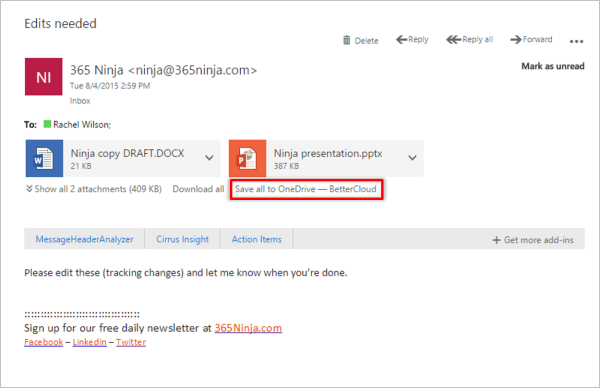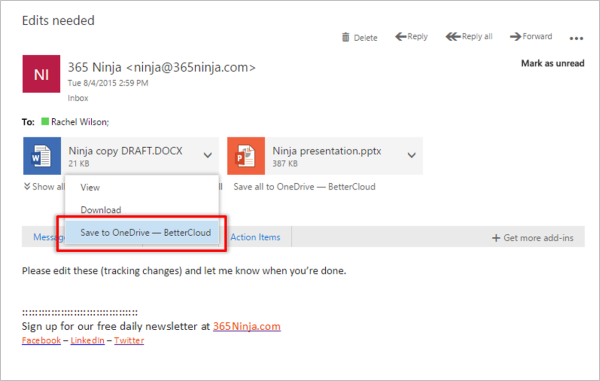11 OneDrive for Business Tips for Boosting Adoption and Creating Power Users
August 5, 2015
6 minute read

More than ever, employees are relying on cloud-based tools that allow them to work smarter and more effectively.
For organizations running Office 365, OneDrive for Business is becoming the focal point for end users and cloud IT admins alike. It’s helping end users collaborate and giving admins additional capabilities to manage their tenant’s influx of data.
Despite OneDrive for Business still being in its infancy, there are a number of capabilities that admins can implement or share with end users to help boost adoption and create power users. Unfamiliarity is a major impediment for end users and it’s stopping them from using OneDrive for Business to its full potential. The 11 OneDrive for Business tips laid out below will help both admins and end users better understand what the tool can do to increase work productivity.
1. Work Offline with the OneDrive for Business Sync Tool
The cloud enables users to work from anywhere, on any device, at any time. But sometimes, you just don’t have internet access. OneDrive for Business offers a tool that helps you get around your Wi-Fi troubles and allows you to work offline.
In order to work without internet access, you first need to download the OneDrive for Business sync app. You’ll then need to sign into Office 365 where you can navigate to OneDrive, find the library you wish to access offline, then press sync. You can sync up to 20,000 files and folders in your OneDrive for Business library.
Microsoft has also clued us into some future syncing capabilities that are just around the corner.
Note: If for some reason you have low bandwidth or accidently began syncing your OneDrive for Business, you can easily pause or stop your OneDrive for Business from syncing.
2. Use Office Delve to Gain Insight into Your Organization
Office Delve is a relatively new product from Microsoft that helps you see what your colleagues are working on across Office 365. Delve integrates with OneDrive for Business so that you can find and share documents as quickly as possible.
Powering Office Delve is a technology called Office Graph that maps the relationships between people and content, according to Microsoft. Delve looks a lot like Pinterest at first glance, pulling from the social network’s card-based interface. The “cards” are made up of documents that are accompanied by a variety of details like comments, likes, views, and tags to provide insight into why each card is important. The cards are dynamic, in that you click on them to launch the document in Office 365, giving you the ability to edit or comment immediately.
Delve is a project management tool and social network wrapped into one. To get a comprehensive overview of the product and how you can use it, follow the links below:
- What is Office Delve?
- How to Use Delve for Office 365: Finding People and Information
- How to Use Delve for Office 365: Grouping and Sharing Documents
3. Quickly Save Attachments to OneDrive for Business
The benefit of having an integrated file sync and share solution lies in its ability to connect to the applications that you use most often. As any Office user can attest, much of your work day is spent in Outlook where you are constantly sending and receiving new documents.
Now, you can easily save your attachments directly into OneDrive for Business, right from the Outlook Web App.
To save all documents in an email, simply select Save to OneDrive or Save all to OneDrive. This will save your documents to a OneDrive folder called Email Attachments; attachments can then be moved from folder to folder from within your OneDrive or sent as cloud attachments.
You can also save a single attachment by accessing more options through the down arrow found on each attachment.
Note: These features are not supported in Outlook 2013.
4. Check Out Your OneDrive for Business Storage Space
With OneDrive for Business, you’ll want to know how much storage space you have available in your organization. As an admin, you can quickly find out by navigating to your Site settings page in OneDrive for Business, and then selecting Storage Metrics. You’ll see a bar in the upper right corner showing the allotted space remaining.
If you’re looking to free up some storage space, a quick way to do so is by emptying your recycle bin.
5. Enabling and Using Version Control
Version control is a great way to stay up to date with the latest changes that you or your fellow co-authors have made to documents.
To take advantage of version control, you need to make sure that you have version history enabled in OneDrive for Business. To find out, select any file in your library, and then click Files > Version History. If Version History is grayed out, you may need to contact your organization’s administrator to enable it.
Admins can choose to enable or remove version control from an entire list or library. Depending on the importance of a document, version control settings can be configured to save a new version every time an edit is made. Admins can also set a version cap, which will delete the oldest version of a document once a certain threshold has been reached.
Once version control is enabled, you can view, restore, or delete a previous version of the document.
6. Configure Links to OneDrive for Business in Your SharePoint
This is great for admins whose organizations are using both SharePoint 2010 and OneDrive for Business. As an admin, you can set up a link that appears in your organization’s SharePoint that will send users directly to their OneDrive for Business accounts.
To set this up, follow the configuration directions outlined in this TechNet article.
Once this is set up, end users will be able to easily navigate from SharePoint to OneDrive for Business, making the transition as simple as possible.
7. Use OneDrive for Business on Your Mobile Device
If your organization uses OneDrive for Business, you can access it on the move through Apple, Android, and Windows Phone devices.
These apps are designed for on-the-go working, so they obviously aren’t as powerful as their web-based or desktop counterparts, but they do come with some inherent capabilities that are unique to their form factor.
With Android devices, you can pin folders to your home screen for quick access to commonly used documents. To do so, after downloading the OneDrive app on an Android device, tap and hold on a blank space of the home screen, then select OneDrive. From there, you’ll be prompted to select a folder that you can then pin to your home screen for easy access.
For enhanced security, you have the option to set up a PIN or use iOS TouchID to access your OneDrive accounts.
8. Create and Host an Online Survey in OneDrive for Business
If your organization uses OneDrive for Business, or you’re just a OneDrive user that wants to poll a group of friends on vacation destination preferences, you can easily create a survey with Excel Online, right from your OneDrive account.
- In OneDrive, click Create, and then Excel Survey.
- In OneDrive for Business, click New, and then Excel Survey.
Note: The next three tips are for personal OneDrive use only and are not available in OneDrive for Business. It’s important that your users understand that the two tools are different from one another. And as an added bonus, users that use OneDrive for personal use will ultimately become more accustom to using OneDrive for Business during work hours.
9. Access Your Other PCs Through OneDrive
The cloud gives you anywhere access to documents, but OneDrive for Windows users takes that access a step further. Through OneDrive, you can actually access your other PCs–even if the files aren’t in your OneDrive folders.
To access documents on other PCs, you’ll need to first enable the “Fetch Files” feature.
10. Embed an Office Document in a Webpage
A rather unknown and great trick for OneDrive is that you can use it to embed documents directly on your website or blog.
Do you have a PowerPoint or Word document that you would like to share with your readers? No problem, just check the box next to the name of the document you’d like to embed, right click, then select Embed. From there, you will need to select Generate which will generate the HTML code that you can use to embed the document on your site.
11. Use IFTTT for OneDrive
IFTTT, or If This Then That, is a tool that automates simple tasks in your everyday life. You can connect IFTTT to your OneDrive and make it simple to do the following:
- Upload all new iOS photos to OneDrive
- Archive incoming attachments from Gmail to OneDrive
- Upload all new Flickr photos you post to OneDrive
Learn more about what you can do with the OneDrive channel on IFTTT.
Finding Value in OneDrive for Business
As Office 365 continues to gain ground, OneDrive for Business will become increasingly important for end users and admins alike. Office 365 admins will need to take advantage of all of the OneDrive for Business management capabilities afforded to them so that users can use the tool to its full potential without unintentionally sharing sensitive data.
As our recent survey data has shown, cloud office systems are proving to be effective catalysts for collaboration and productivity, but as an Office 365 admin, you will likely face the hurdle of user adoption.
Equipped with these tips, you can help your users see the value in OneDrive for Business and adjust to the inevitable change that will make the file sync and share tool central to your employee’s work routines.








